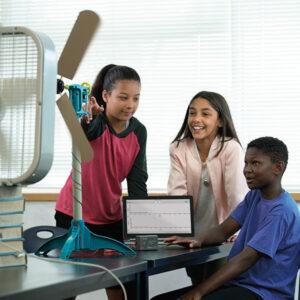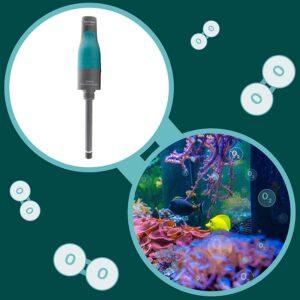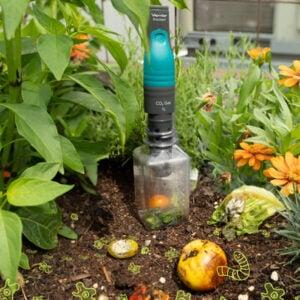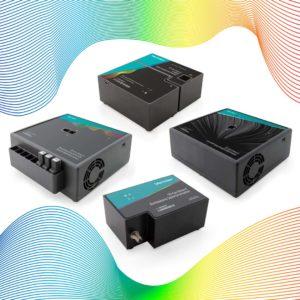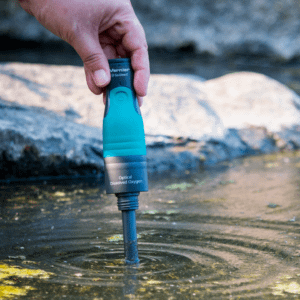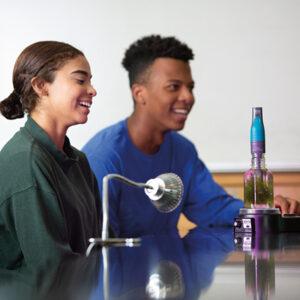
Sharing ideas and inspiration for engagement, inclusion, and excellence in STEM
Spooky Science: Five Hands-On Experiments with a Halloween Spin
Halloween is the perfect opportunity to make science a little more engaging—and a lot more memorable. With just a touch of creative framing, you can add a spooky, seasonal twist to these Vernier experiments across chemistry, biology, or physics.
From exploring the glow in glowsticks to tracking heart rates during a scare, these hands-on ideas use Go Direct® sensors and Vernier Graphical Analysis® to help students explore core science concepts through a new (and slightly eerie) lens.3 Hands-On Ways to Help Students Learn Photosynthesis and Cellular Respiration
Photosynthesis and cellular respiration are essential concepts in any biology class, but because they’re abstract, they’re often tricky for students to grasp. As a former biology educator, I know how challenging it can be to help students move beyond memorizing equations to actually seeing what’s happening inside plant cells. For example, many of my students once believed that only photosynthesis happens during the day, and that cellular respiration only happens at night—they really struggled to see how the pathways are connected. Helping students visualize these invisible processes with data can illuminate some of those connections.
5 AP Exam Tips from Vernier Trendsetters
Every summer, AP teachers gather for the annual AP exam reading, a week where educators grade thousands of exams, sharpen their understanding of the rubric, and trade stories about what helps students succeed. During a recent Vernier Trendsetters Coffee Chat, AP science teachers Sarah Shaw, Chris Coker, and Diane Vrobel, who teach across chemistry, physics, biology, and environmental science, shared their biggest takeaways from exam reading and offered practical tips to bring back to the classroom.
3 Hands-On, Low-Prep Sensor Activities to Start the School Year
The first week of school is a great time to lean into student curiosity, help everyone get comfortable with your lab routines and tools, and build students’ confidence with Vernier sensors and software. Whether you teach middle school science, high school science, or introductory college courses, the goal is the same: Empower students to use real-time data to make sense of the world.
Empowering Teachers, Engaging Students: A New Era of STEM Learning with Vernier Connections Powered by Penda
For over 40 years, Vernier Science Education has been a trusted leader in hands‑on STEM education, equipping educators with the tools and technology to bring real-world data collection and analysis into the classroom. Penda Learning has developed a digital learning platform grounded in cognitive science‑using gamification and research‑based strategies to keep students motivated while boosting engagement and achievement in standards‑based science instruction.
Stories That Stick: Ideas for Integrating Science and Language Arts
Whether it’s through science fiction novels, engaging literary nonfiction, or comics, educators are finding creative ways to bring literacy into STEM learning. These approaches echo the research‑backed connections between Common Core literacy standards and the NGSS Science and Engineering Practices, particularly in the areas of argumentation, communication, and evidence‑based reasoning.
Four 3D-Aligned Experiments for Your Middle School Classroom
Middle school is a great time to give students more experience collecting and working with data. Whether they’re testing chemical reactions, tracking environmental changes, or exploring energy systems, hands-on investigations help them connect big science ideas to the world around them.
From Seafloors to Salinity: 3 Hands-On Investigations into Ocean Science Phenomena
Covering more than 70% of Earth’s surface, the ocean plays a vital role in our planet’s climate, ecosystems, and everyday life. World Ocean Day (June 8) and World Ocean Month offer timely opportunities to explore this dynamic system through interdisciplinary learning that connects chemistry, biology, Earth science.
Celebrating Women in STEM: Exploring Diverse Careers, Data, and Discovery
In honor of Women in STEM Month, we spoke with three professionals who use data collection, research, and hands-on science to make an impact in their fields. From food science to environmental compliance, their work showcases the many ways STEM shapes our world and the unique career opportunities your students might not know about. We’ve included engaging classroom experiments that connect to each professional’s field, helping you inspire students by bridging classroom learning with real-world STEM careers.
Animal Acoustics: Analyzing Sound Waves in Physics and Biology
How can physics principles help us better understand biological phenomena? Sound provides a perfect opportunity to bridge these disciplines. By analyzing biological sound patterns—such as whale songs, bird calls, or bat echolocation—students can explore the physics of waves while gaining insights into animal communication and behavior.
In physics, sound is typically studied in units on waves and vibrations, where students examine properties like frequency, amplitude, and wave interference. These same principles also play a role in biology, where sound is crucial for animal behavior, communication, and survival. Using tools like the Go Direct® Sound Sensor and Go Direct Motion Detector, educators can help students connect wave properties to real-world biological systems and take a cross-cutting approach that emphasizes structure and function in both subjects.Color Countdown: Investigating Chemical Kinetics with a Forensic Twist
What makes forensic science such a compelling way to teach chemistry? Whether or not students are fans of crime shows like CSI, NCIS, or Bones, using storytelling to frame investigations helps transform abstract concepts into engaging, high-stakes problem solving. Students aren’t just running a reaction in a cuvette—they’re solving a mystery. And to make their case, they must analyze evidence, interpret data, and communicate their findings like forensic scientists.
In this hands-on experiment, students use the Go Direct® SpectroVis® Plus Spectrophotometer to explore how concentration, absorbance, and reaction rates are connected as they investigate whether a food dye and bleach mixture could act as a timer on a suspected bomb. By determining the reaction order and half-life, students uncover and explain how this chemical process could be used in a forensic scenario.Everything You Need to Know About the Logger Pro Transition
For more than 20 years, Logger Pro™ has been a trusted tool for educators helping students explore real-world data in real time. To our long-time Logger Pro users, thank you for making this application a cornerstone of your classrooms. We’re proud of its legacy and excited to share this next chapter of data analysis with you.
Three Biology Experiments with Spectroscopy: From Plant Pigments to Proteins
Spectroscopy isn’t just a tool for measuring light—it's also a powerful way to help students understand core biological processes! While many biologists may see spectrometers as just “black boxes,” these hands-on tools are an engaging, easy-to-use way to help students explore real-world phenomena and visualize complex biological systems—from plant pigments and photosynthesis to proteins and evolution!
Our Top Blog Posts of 2024
Wow, 2024 has been an unforgettable year! From launching our inaugural Vernier Trendsetters Community cohort and witnessing a total solar eclipse alongside educators across the path of totality, to welcoming Jill Hedrick as our new CEO, we’ve celebrated many milestones. This year also saw the release of exciting new tools, including the Cart Fan, Go Direct® Force Plate, Go Direct Salinity Sensor, and Go Direct Soil Moisture Sensor!
A Cut Above: How CASE Students in Iowa Are Using Data to Elevate Local Pork Production
When it comes to innovation, CASE educator Jamie Christiansen and her agricultural science students are bringing home the bacon—and the data—to help local pork farmers thrive. Christiansen, who teaches in the Midland Community School District in Wyoming, Iowa, is passionate about hands-on, inquiry-based learning that connects students directly with real-world agricultural challenges in their community.
Investigating Aquatic Life: A Ready-to-Use Experiment on Dissolved Oxygen
From supporting aquatic life to maintaining a balanced ecosystem, dissolved oxygen (DO) is a critical component of a healthy aquatic environment—whether it is an ocean, river, pond, or local watershed. To help students understand exactly what DO is and how it impacts waterways, you can incorporate a hands-on experiment into your biology or environmental science lessons. This can help students meaningfully connect what they are learning with the world around them.
Why Isn’t There Dead Stuff Everywhere?! Exploring the Nature of Decomposition with a CO2 Gas Investigation
All species in an ecosystem, from critters on the forest floor to lions in the Serengeti, are directly or indirectly nourished by “dead stuff.” This organic matter, whether fallen leaves, rotting fruit, or decomposing organisms, is a crucial part of the continuous cycle of matter and energy flow in an ecosystem. While much attention is usually given to producers and consumers, an often ignored part of the food web—decomposers—play an equally vital role. These organisms break down dead matter, releasing carbon (in the form of carbon dioxide) and other nutrients back into the environment. With the Go Direct® CO2 Gas Sensor, students can observe this process in real-time, gaining a deeper understanding of the carbon cycle and the importance of decomposition.
Where Math Meets Science: Connecting Vernier Go Direct Sensors and TI-Nspire Technology
Looking for ways to make math more accessible to your students? Help them build confidence in math and science concepts by using real-time data collection! When students are tasked with exploring real-world phenomena, math transforms from an abstract, intimidating concept into a practical tool that students can use to develop and articulate answers to questions like, “Why are headlights on a car dimmer at a distance?” or “Why do I feel warmer wearing a black shirt on a sunny day?”
With enhanced compatibility between Vernier and Texas Instruments, students can now explore math in tangible, real-world scenarios by wirelessly capturing and analyzing real-time data on their TI-Nspire™ CX II graphing calculators. By integrating math and science, educators can enrich student comprehension, deepen their understanding of the natural world, and prepare students for careers in STEM.How to Introduce Your Students to Data-Collection Basics
Whether studying CO2 changes during photosynthesis or investigating the conservation of momentum during a collision, students need to be able to do more than just plot points on a graph—they need to understand the story that a graph tells. One incredibly effective way to develop this kind of data literacy is to incorporate data-collection technology and investigations into your instruction. Real-time data collection not only helps students build stronger connections between abstract scientific concepts and the real world but also helps students transform raw data into meaningful insights through tabulation, graphs, visualization, and statistical analysis.
Choosing the Right pH Sensor for Your Classroom or Lab
From testing household acids and bases to evaluating soil and water quality for agriculture, measuring and interpreting pH data is an essential skill across scientific disciplines and education levels. Our pH sensors all offer similar accuracy, response time, and sensitivity. So, which one should you buy? It depends on how and where you plan to use your pH sensor. Follow these guidelines to help you choose the right tool for your specific lab or classroom needs.
Five Trailblazing Female Asian American & Pacific Islander Scientists with Impactful STEM Legacies
May is National Asian American and Pacific Islander Heritage Month, an excellent time to help your students learn about the pivotal contributions Asian Americans, Native Hawaiians, and Pacific Islanders have made to the STEM fields—and continue to make today! As we celebrate their accomplishments, it’s also important to acknowledge the gaps in visibility within these groups, particularly among AAPI women in science. For example, recent studies have shown women in this demographic are notably less likely to be employed in leadership positions in STEM, even when highly educated. This discrepancy also persists in educational resources, where textbooks continue to underrepresent women and people of color in STEM. To help spotlight their considerable academic and scientific research contributions, here are five influential AAPI women whose stories and achievements you can share with your students, as well as a few experiment ideas to connect with their research.
Which Vernier Sensors Should I Use to Explore the Respiratory System?
Understanding the respiratory system is a fundamental component of human physiology that provides students with critical insights into how their bodies function. For educators looking to support their human physiology lessons with technology, Vernier offers a variety of sensor options that can be tailored to different educational needs and budgets. If you’re trying to decide between the Go Direct® Spirometer and the Go Direct Respiration Belt, we’ve highlighted their distinct features and advantages to help you select the right tool for engaging your students in effective respiratory system studies.
Connecting Students to the Natural World through Service and Place-Based Learning in Their Own Backyard
After 30 years of teaching science at East Palestine Schools in Ohio, Dr. Lisa Bircher is confident about one thing: students deserve to be involved in experiences that expand beyond the classroom. Whether that’s monitoring water quality in local streams and lakes with probeware or simply sorting through recyclables in the outdoor area behind the school property, students learn best when they are actively engaged in real-world, hands-on learning opportunities.
Bircher earned the 2023 NABT Ecology/Environmental Science Teaching Award, sponsored by Vernier Science Education, and recently made the transition into retirement. As part of her plans for the future, Bircher is exploring going into ministry, laughing, “It’s a lot like teaching, honestly. I just don't have the really cool lab equipment.”Ready, Set, Science! Get Your Science Game On with These Four Sports‑Themed Experiments
We had such a blast at NSTA Denver 2024 last week! One of our big highlights this year was getting to mix science and sports with fun, athletics-inspired activities. Below we’re sharing four of our favorite sports-themed experiments you can try out to elevate your classroom game!
The Farm-to-Classroom Experience: CASE-Awardee Anita DeWeese Makes Big Impacts in Ag Engagement and Assessment
Bottle feeding baby lambs isn’t an everyday experience for most students in Anita DeWeese’s class at Skyline Schools in Kansas state. But thanks to her family farm, it’s one of the unique experiences DeWeese is able to bring to her agricultural science classroom to help bridge the gap between academic curriculum and the realities of farm life.
How To Get The Best Data When Measuring Dissolved Oxygen
In biology, ecology, and environmental science classes, accurate measurement of dissolved oxygen (DO) levels in water is crucial for understanding aquatic ecosystem health. Collecting precise data is key, and sensors like the Vernier Optical DO Probe or Go Direct® Optical Dissolved Oxygen Probe are specifically designed for the task. However, it can be easy to gather inaccurate or misleading data if careful steps aren’t taken. This blog post shares some of our best practices for collecting precise DO data to ensure meaningful results with your students.
Five Essential Steps to Get Your Lab Ready for the New School Year
Is your STEM lab fully prepared for classes this fall? Taking the time to assess your equipment at the start of the year can prevent future headaches and mitigate expenses down the road. Ensure your lab is science experiment-ready and in optimal working condition with this simple checklist.
Back-to-School Experiments to Kick-Start Your School Year
As we gear up to welcome students back to the classroom, it’s the perfect time to strategically introduce (or reintroduce) the fundamental principles of data collection. No matter the subject, understanding how to collect, analyze, and interpret data is not only key to fostering good inquiry, it’s also a fun way to spark engagement in students as they come back to class from summer break.
We’re sharing our favorite back-to-school science experiments that use some of our most popular sensors, including the Go Direct® Temperature Probe, the Go Direct Conductivity Probe, and the Go Direct Motion Detector. Give these a try to get your students moving, mixing, measuring, and observing in the classroom this fall!Meeting the Needs of All Learners in Every Vernier Connections™ Lesson
At Vernier, our goal is to help all students become STEM-literate citizens. So, as we develop lessons for Vernier Connections, it is critical that we design a journey that will support the learning of all students.
Everything You Need to Know about Summer Sensor Storage
Proper storage over the summer is key to extending the useful life of your laboratory’s sensors. Before you enjoy your well-deserved summer break, it’s a great idea to take stock of your Vernier probeware and make sure it’s correctly stored for the next few months.
Canoes, Conchs, and CO₂ Gas Sensors: Hands-On Environmental Science Learning in the Florida Wetlands
Monitoring water quality is a great way to engage students in hands-on environmental science learning. For Louise Chapman’s students, it has also provided opportunities to make a positive impact on their local community and environment.
How to Choose the Right Spectrometer for You
Spectrometers are a great tool for helping your students explore important scientific concepts across a range of biology, chemistry, and physics courses—and Vernier offers a suite of spectrometers that are fast, compact, and easy to use.
Four Experiments to Help Your Students Explore the Science Behind Climate Change
Climate change is a complex, long-term process, so it can be challenging to conduct classroom experiments that show the phenomenon.
Determining the Best Light Source for Photosynthesis
One of the fundamental concepts in biology is photosynthesis, the process by which plants use carbon dioxide, light, and water to make their own food. Sunlight contains a broad spectrum of wavelengths, both visible and invisible—but plants use only specific parts of the visible spectrum for photosynthesis.
Giving High School Students Real-World Experience with Modern Agriculture
Over the 30 years that Joel Rudderow has been teaching agricultural science, the agricultural industry has changed a great deal. With advances in everything from machinery to irrigation, the work that farmers do today looks a lot different from what their predecessors did.
Answers to the Top Three Questions about the Go Direct® EKG Sensor
If you’ve been teaching human physiology for a long time, it’s likely that you have had to use traditional electrocardiogram (EKG) sensors, which often involve an assortment of switches and knobs that require manual adjustment.
Celebrating Darwin Day with Vernier Technology
Looking for an innovative way to teach your students about Charles Darwin’s theory of evolution? Comparative physiology experiments are a great approach to explore this central concept in biology.
Answers to the Top Five Questions about pH Sensor Care
Whether you teach college chemistry, high school biology, or middle school science, a pH sensor is a great tool to help your students explore the fundamental scientific concept of pH.
Unlock Scientific Innovation with These College Experiments
Vernier offers more than 1,000 experiments in biology, chemistry, engineering/robotics, and physics that can promote STEM literacy and help you integrate data-collection technology into your courses.
Elevate Hands-On STEM Learning with These K–12 Experiments
Vernier offers more than 1,000 experiments in biology, chemistry, engineering/robotics, and physics that can promote STEM literacy and help you integrate data-collection technology into your classes.
Bring Biology Concepts to Life with the Go Direct® CO₂ and O₂ Gas Sensors
In biology courses, students tend to learn about big-picture concepts that can be difficult to comprehend, such as cellular respiration, photosynthesis, and cellular metabolism.
Five Research-Based Best Practices for STEM Education
The quest for high-quality STEM education starts with having a solid foundation grounded in research. But what exactly does the research say about high-quality STEM education?
College Experiments of the Month: Unlock Scientific Innovation
Vernier offers more than 1,000 experiments in biology, chemistry, engineering/robotics, and physics that can promote STEM literacy and help you integrate data-collection technology into your courses.
K–12 Experiments of the Month: Elevate Hands-On STEM Learning
Vernier offers more than 1,000 experiments in biology, chemistry, engineering/robotics, and physics that can promote STEM literacy and help you integrate data-collection technology into your classes.
Getting Students Involved and Invested in Their Own Learning with User-Friendly Vernier Technology: A Q&A with Alexandra Boyd
Alexandra Boyd teaches AP Physics at Apex Friendship High School in Apex, North Carolina. Last year, she won a 40th anniversary educator grant from Vernier, which included $1,000 in Vernier technology. We sat down with Boyd to discuss the impact of the grant on her and her students. The interview has been edited for length and clarity.
Versatile Go Direct® Light and Color Sensor Helps Illuminate Concepts Across the Science Curriculum
Good things come in small packages—including the Go Direct Light and Color Sensor.
College Experiments of the Month: Unlock Scientific Innovation
Vernier offers more than 1,000 experiments in biology, chemistry, engineering/robotics, and physics that can promote STEM literacy and help you integrate data-collection technology into your courses.
K–12 Experiments of the Month: Elevate Hands-On STEM Learning
Vernier offers more than 1,000 experiments in biology, chemistry, engineering/robotics, and physics that can promote STEM literacy and help you integrate data-collection technology into your classes.
Using Vernier Technology to Learn about Water Quality and Promote Partnerships: A Q&A with Varun Paul, PhD
Varun Paul, PhD, is an assistant professor in the Department of Geosciences at Mississippi State University. Last year, he won a 40th anniversary educator grant from Vernier, which included $1,000 in Vernier technology. We sat down with Paul to discuss the impact of the grant on him and his students. The interview has been edited for length and clarity.
K–12 Experiments of the Month: Elevate Hands-On STEM Learning
Vernier offers more than 1,000 experiments in biology, chemistry, engineering/robotics, and physics that can promote STEM literacy and help you integrate data-collection technology into your classes.
College Experiments of the Month: Unlock Scientific Innovation
Vernier offers more than 1,000 experiments in biology, chemistry, engineering/robotics, and physics that can promote STEM literacy and help you integrate data-collection technology into your courses.
Using Vernier Technology to Ensure Students Get the Best Possible Laboratory Experience: A Q&A with Arianna Demmerly
Arianna Demmerly, PhD, is the laboratory coordinator for the Chemistry and Biochemistry Department at the University of Alaska Fairbanks. Last year, she won a 40th anniversary educator grant from Vernier, which included $1,000 in Vernier technology. We recently sat down with Demmerly to discuss the impact of the grant on her and her students. The interview has been edited for length and clarity.
College Experiments of the Month: Unlock Scientific Innovation
Vernier offers more than 1,000 experiments in biology, chemistry, engineering/robotics, and physics that can help you inspire students and integrate data-collection technology into your science courses.
All three of this month’s experiments were featured in or inspired by recent Vernier webinars. Our webinars are a great way to see our experienced educational technology specialists demonstrate Vernier experiments, answer your top questions, and provide tips about using our products to engage your students. Visit our website to check out webinar recordings and register for upcoming webinars.K–12 Experiments of the Month: Elevate Hands-On STEM Learning
Vernier offers more than 1,000 experiments in biology, chemistry, engineering/robotics, and physics that can help you inspire students and integrate data-collection technology into your STEM classes.
All three of this month’s experiments were featured in or inspired by recent Vernier webinars. Our webinars are a great way to see our experienced educational technology specialists demonstrate Vernier experiments, answer your top questions, and provide tips about using our products to engage your students. Visit our website to check out webinar recordings and register for upcoming webinars.College Experiments of the Month: Unlock Scientific Innovation
Vernier offers more than 1,000 experiments in biology, chemistry, engineering/robotics, and physics that can help you inspire students and integrate data-collection technology into your science courses.
All three of this month’s featured experiments involve our spectrometers. To further explore the use of spectrometers, check out our Illuminate Spectroscopy webinar.Spotlight on Our Go Direct® Spectrometers
Fast. Compact. Easy to use.
K–12 Experiments of the Month: Elevate Hands-On STEM Learning
Vernier offers more than 1,000 experiments in biology, chemistry, engineering/robotics, and physics that can help you inspire students and integrate data-collection technology into your STEM classes.
All three of this month’s featured experiments involve our spectrometers. To further explore the use of spectrometers, check out our Illuminate Spectroscopy webinar.K–12 Experiments of the Month: Elevate Hands-On STEM Learning
Vernier offers more than 1,000 experiments in biology, chemistry, engineering/robotics, and physics that can help you inspire students and integrate data-collection technology into your STEM classes. We will be featuring at least one of our experiments in each edition of The Caliper.
College Experiments of the Month: Unlock Scientific Innovation
Vernier offers more than 1,000 experiments in biology, chemistry, engineering/robotics, and physics that can help you inspire students and integrate data-collection technology into your science courses. We will be featuring at least one of our experiments in each edition of The Caliper.
Spark Scientific Curiosity with These Award-Winning Apps
To help educators reignite students’ love of learning science this spring, Vernier is providing
STEM Education Innovation: Using Data Collection to Prepare Students for the Agricultural Workforce
Note: A version of this story was originally posted on the Vernier website in October 2019.
Technology plays a significant role in making modern agricultural practices more efficient and profitable. Sensors monitor environmental conditions and analyze the soil, robots assist in weed control and during harvest, and drones provide aerial imagery to monitor crop growth.Science Education Innovation: Taking Human Anatomy and Physiology Labs Online
We’re always excited when educators share the ways they use Vernier products in their science courses—and we’re always so impressed by their ingenuity. We will be showcasing at least one example of science education innovation in each edition of The Caliper.
Classroom Resources for Examining the Impacts of Climate Change
Teaching students about climate change can be challenging; it’s a broad, interdisciplinary topic, and it’s not always part of an established curriculum. However, teaching students about the impact of climate change can be relatively simple.
Three Must-Watch Videos about Climate Change
Although climate change is a complex topic, many free videos and documentaries are available to help educators teach students about climate change and how it impacts their everyday lives.
Celebrating Latinx Scientists and Their Work: Resources for Your Classroom
National Hispanic Heritage Month offers a great opportunity for students to learn about the many Latinx contributions to STEM.
Breaking Down Barriers for Remote Learning
When the global pandemic forced the closure of college science departments across the nation, Dr. Kari van Zee, Dr. Ryan Mehl, Dr. Rick Cooley, and graduate student Phil Zhu—department faculty and research members at Oregon State University—had to think fast. They were faced with the unprecedented challenge of changing their hands-on senior-level research methods course so it could support remote and hybrid models of learning.
Exploring Ocean Acidification Easily and Affordably
Climate change is the cause of a number of devastating consequences facing our planet. However, one often overlooked problem keeping the environmental science community busy right now is ocean acidification.
Three Ways to Enliven Remote Learning with Vernier Graphical Analysis Pro
Since COVID-19 cases remain stubbornly high across the country, it’s clear that remote learning isn’t going away. And while this teaching concept isn’t new anymore, many STEM educators are still struggling to beat video conference fatigue and keep students engaged in the remote classroom. For science teachers who depend on hands-on experiments to demonstrate scientific concepts, remote learning presents a unique question: how do you remotely teach science in a way that holds students’ attention?
Agricultural Science Teachers Honored with Prestigious Awards
At the 2019 National Association of Agricultural Educators (NAAE) Convention, three outstanding educators were presented with prestigious awards from Curriculum for Agricultural Science Education (CASE).
Investigate Plant Pigments and Olive Oil
Absorbance of plant pigments from spinach and cherry
Why Use Two Probes When You Only Need One?
Vernier helps you keep experiments simple. Using our multi-channel Go Direct® Optical Dissolved Oxygen Probe, students can simultaneously measure dissolved oxygen concentration (mg/L), percent saturation (%), and water temperature. Students normally need to use both a dissolved oxygen probe and a temperature probe to learn how the dissolved oxygen content of water depends on the water temperature. This is an important ecological concept, as some organisms, such as salmon, require high concentrations of dissolved oxygen in their water. Your students no longer need an additional probe to measure temperature when they use a Go Direct Optical Dissolved Oxygen Probe.
Celebrate Brain Awareness Week with Your High School Students
Brain Awareness Week is March 11–17. This is an excellent opportunity for you to discuss the importance of neuroscience in your class using engaging activities. As a former instructor, I often found that teaching neuroscience could be challenging. Neuroscience is a broad field, and students need to understand molecular and cellular concepts, as well as brain anatomy and physiology. After years of teaching, I found several ways that seemed to make neuroscience easier for my students to understand. I’d like to share them with you.
How to Introduce Evolution to Your Students
Darwin Day is coming up on Wednesday, February 12th. It presents an excellent opportunity to introduce or discuss the concept of evolution by natural selection with your students. While I’m now part of the Vernier Biology Department, I previously worked for 15 years as a university biology professor and know first hand how creative teachers have to get when introducing new concepts to a classroom of students. There are plenty of ways to get students excited about evolution, and here are a few ideas.
What Are the Best Light Sources For Photosynthesis?
Photosynthetic organisms such as plants and algae use electromagnetic radiation from the visible spectrum to drive the synthesis of sugar molecules. Special pigments in chloroplasts of plant cells absorb the energy of certain wavelengths of light, causing a molecular chain reaction known as the light-dependent reactions of photosynthesis. The best wavelengths of visible light for photosynthesis fall within the blue range (425–450 nm) and red range (600–700 nm). Therefore, the best light sources for photosynthesis should ideally emit light in the blue and red ranges. In this study, we used a Go Direct® SpectroVis® Plus Spectrophotometer with a Vernier Spectrophotometer Optical Fiber and LabQuest 2 to collect spectra from four different light sources. This allowed us to determine the wavelengths emitted by each source and to get an idea of their relative intensities.
Tips and Tricks for Success with Inquiry‑Based Enzyme Activities
Understanding enzyme action is a fundamental concept in biology. The “Testing Catalase Activity” investigation in our Investigating Biology through Inquiry book is a very popular activity for investigating enzyme action. Our O2 Gas Sensor and Gas Pressure Sensor can be used in this activity along with some very simple materials, such as yeast and hydrogen peroxide.

Sign up for our newsletter
Stay in the loop! Beyond Measure delivers monthly updates on the latest news, ideas, and STEM resources from Vernier.
Beyond Measure started as a printed, biannual newsletter in 1984. See the evolution of STEM education over 41 years.







